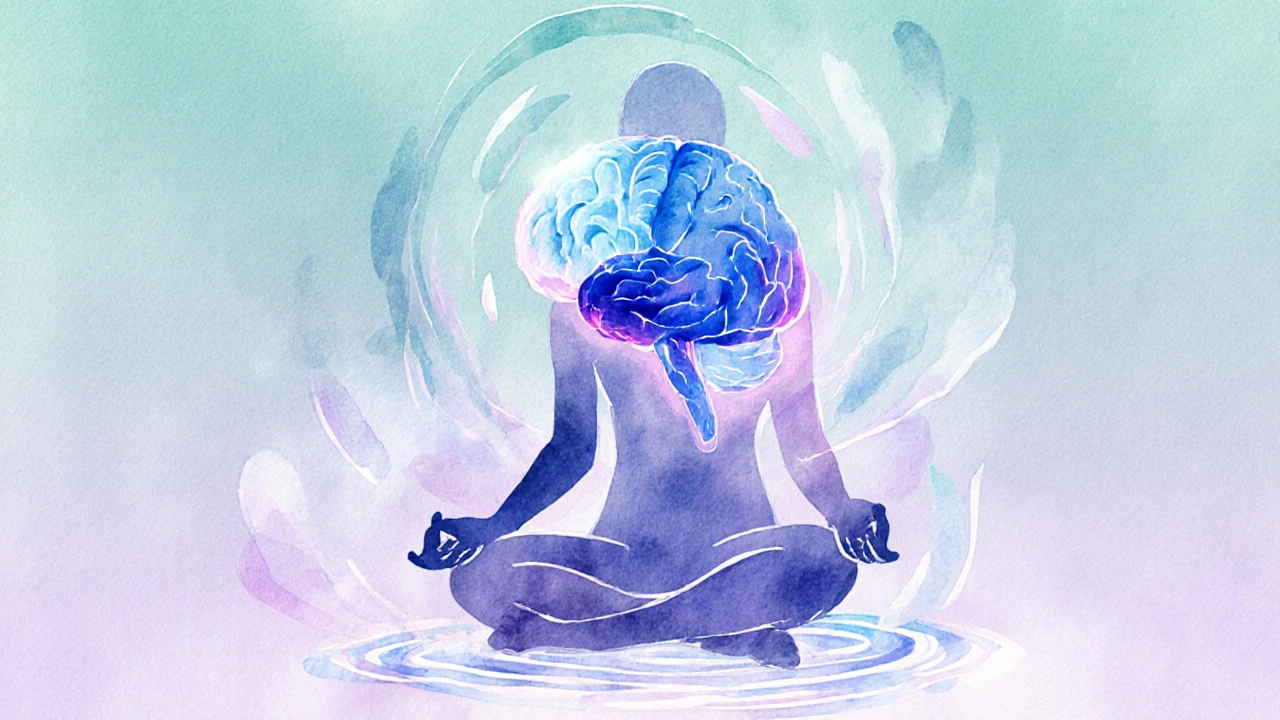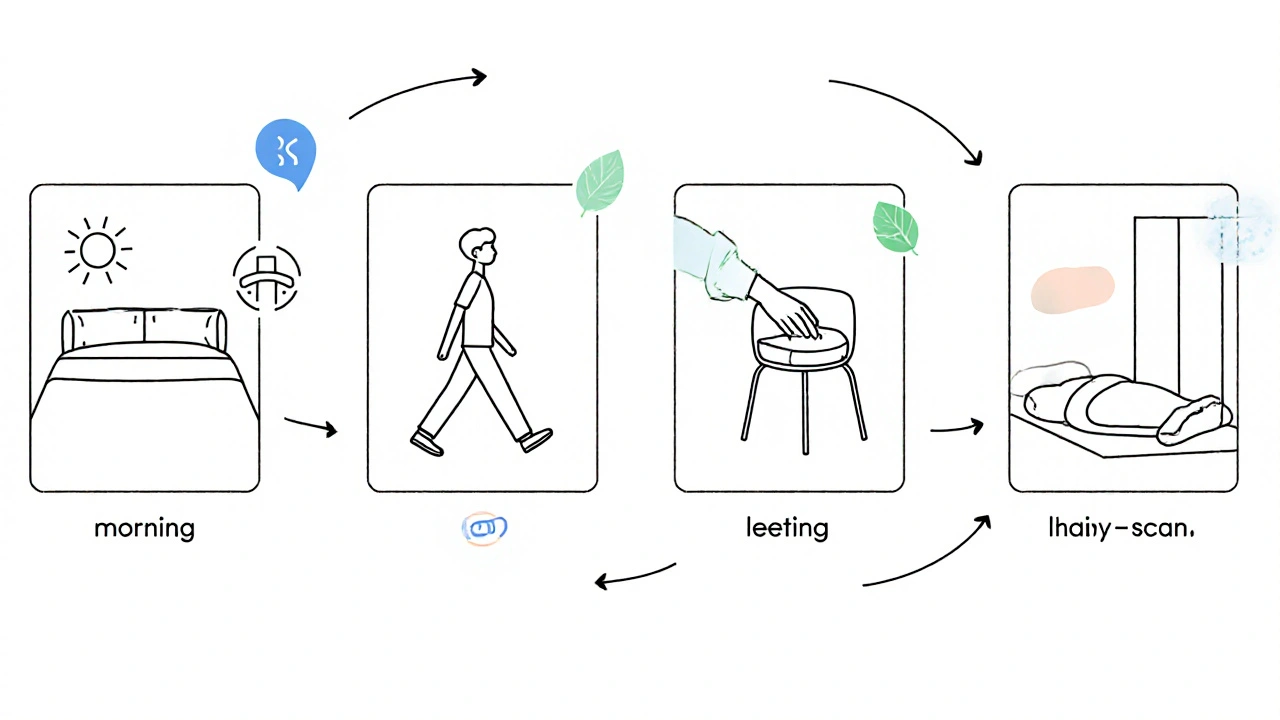Mindfulness Technique Selector
Find Your Perfect Practice
Answer these simple questions to get a personalized mindfulness recommendation. This tool is based on techniques from the article and research on beginner-friendly practices.
Your Recommendation
When you hear the word Mindfulness is the practice of paying attention to the present moment without judgment, you might picture a monk on a mountaintop, but it’s actually a simple skill anyone can train. If you’re looking for a quick way to lower stress, mindfulness offers proven benefits that fit into even the busiest schedule.
What Exactly Is Mindfulness?
At its core, mindfulness means bringing your full awareness to whatever you’re doing right now-whether that’s drinking a cup of tea, walking to the bus stop, or sitting at your desk. Unlike day‑dreaming or autopilot habits, mindfulness asks you to notice thoughts, feelings, and physical sensations as they arise, without trying to change them.
Researchers often compare mindfulness to a mental gym: the more you practice, the stronger your attention and emotional regulation become. A 2023 meta‑analysis of 73 trials found that regular mindfulness practice can reduce perceived stress by an average of 30% and improve sleep quality by 22%.
Why Start Now? The Science Behind the Benefits
Mindfulness isn’t just feel‑good fluff. It triggers real changes in the brain. The prefrontal cortex, responsible for decision‑making and self‑control, becomes thicker after eight weeks of consistent practice. Meanwhile, the amygdala-your stress alarm-shows reduced activity, meaning you’re less likely to over‑react to everyday annoyances.
Beyond neuroplasticity, mindfulness helps regulate cortisol, the hormone that spikes during stress. Lower cortisol translates into steadier blood pressure, better digestion, and a calmer mood. In short, a few minutes a day can protect both mind and body.
Core Principles Every Beginner Should Know
- Non‑judgment: Observe what’s happening without labeling it “good” or “bad.”
- Curiosity: Approach each sensation or thought with an inquisitive mind.
- Beginner’s Mind: Treat familiar experiences as if you’re encountering them for the first time.
- Patience: Progress is gradual; there’s no need to force results.
Keeping these attitudes in mind makes it easier to stay consistent, especially when the mind wanders-something it will do, and that’s perfectly okay.

Simple 5‑Minute Practice to Get Started
- Find a comfortable seat. You can sit on a chair, a cushion, or even stand if that feels better.
- Set a timer for five minutes. Knowing you have a clear end point reduces the urge to check your phone.
- Close your eyes gently and bring attention to your Breathing (the natural rhythm of inhaling and exhaling). Notice the rise and fall of your chest or the feeling of air at the nostrils.
- When thoughts drift, silently label them-"thinking," "planning," "worrying"-and then return to the breath.
- At the end of the timer, open your eyes slowly, stretch, and notice any shift in mood or tension.
This micro‑practice builds the foundation for longer sessions later on. The key is consistency, not length.
Common Pitfalls and How to Dodge Them
- Expecting Immediate Calm: Mindfulness often brings hidden tension to the surface before it eases. Trust the process.
- Over‑Analyzing: If you start dissecting each thought, you lose the present‑moment focus. Stay with simple labels.
- Skipping Sessions: Irregular practice stalls progress. Aim for a daily cue-like brushing your teeth-to trigger a quick session.
- Rigid Posture: Comfort matters. A strained body distracts the mind; adjust your seat as needed.
When you notice any of these habits, gently bring the intention back to the core principles mentioned earlier.
Building a Sustainable Daily Routine
Integrating mindfulness into everyday life works best when you tie it to existing habits. Here’s a sample flow:
- Morning: 3‑minute breathing scan right after you get out of bed.
- Commute: Practice Mindful Walking (walking while paying close attention to each footfall and surrounding sounds) for 5 minutes if you’re on foot, or a body‑scan while on public transport.
- Work Break: 2‑minute pause to notice the sensations in your hands or the texture of your chair.
- Evening: 5‑minute guided Body Scan (a systematic awareness of each body part from toes to head) before sleep.
Adjust the timing to fit your schedule; the goal is to create multiple “mindful moments” throughout the day.

Choosing a Technique That Resonates
While breathing is the most common anchor, other techniques can suit different personalities.
| Technique | Focus Anchor | Typical Duration | Best For |
|---|---|---|---|
| Breathing | Inhale/Exhale | 1‑10 min | Quick stress relief |
| Body Scan | Physical sensations | 10‑30 min | Deep relaxation, insomnia |
| Mindful Walking | Footsteps & surroundings | 5‑20 min | Active people, commuters |
| Loving‑Kindness | Compassion phrases | 5‑15 min | Emotional openness, relationships |
Try each for a week and note which feels most natural. There’s no right or wrong-just what helps you stay present.
Resources and Next Steps
When you’re ready to deepen the practice, consider these trusted tools:
- Headspace’s “Basics” course - short videos and guided meditations for absolute beginners.
- Insight Timer - a free app with over 50,000 guided sessions, including body scans and loving‑kindness meditations.
- "The Miracle of Mindfulness" by Thich Nhat Hanh - a classic read that blends stories with practical exercises.
- Local community centers in Perth often host weekly mindfulness meet‑ups; a shared practice can boost motivation.
Remember, the journey isn’t about perfection. It’s about showing up, even for a minute, and gently guiding yourself back whenever you drift. Over weeks, those minutes add up to a calmer, clearer mind.
Frequently Asked Questions
How long should a beginner meditate each day?
Start with 5 minutes once or twice daily. Consistency beats length; you can gradually extend to 10‑15 minutes as it feels comfortable.
Do I need a special cushion or room?
No. Any quiet spot where you won’t be interrupted works. A chair, a park bench, or even the bathroom floor are fine as long as you can sit upright.
What if my mind keeps wandering?
Wandering is natural. Gently label the distraction (e.g., "thinking") and guide your attention back to the anchor without self‑criticism.
Can mindfulness help with anxiety?
Yes. Studies show regular mindfulness reduces anxiety symptoms by up to 40% by lowering the brain’s threat response and improving emotional regulation.
Is mindfulness a religious practice?
No. While it has roots in Buddhist traditions, modern mindfulness is secular and focuses on mental skills rather than spiritual beliefs.






